+10 intellect
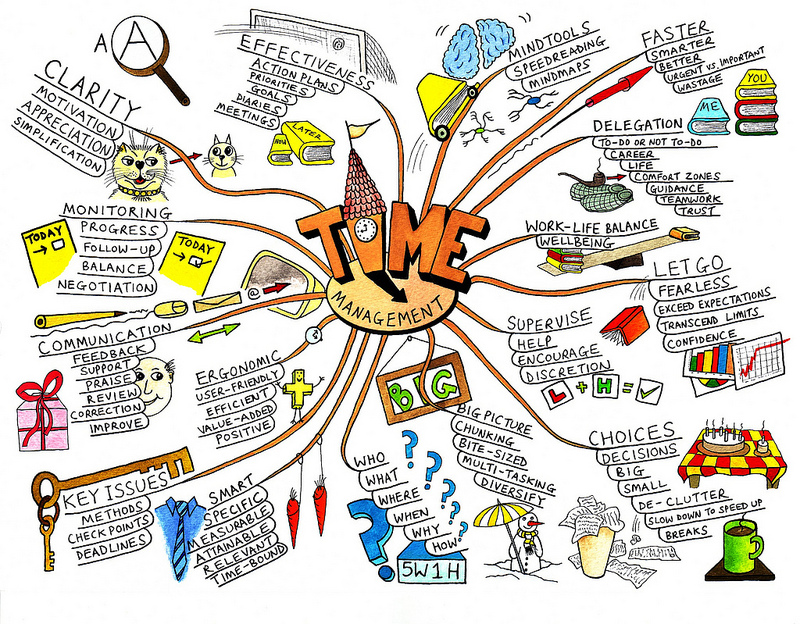
One way or another, practically each of us used in his life the technique of intellect cards or Mind Mapping. This is just a simple radial scheme, but with the right approach it can be turned into a powerful tool for analytics and information synthesis, which is always at hand and quite simple to use. And what is most interesting, the development of technology is so natural for our brain that it takes only a few minutes ...
What does science say?
I will not go into details, I will give only the main points:
')
For our brain, multitasking and parallel perception of information is natural. When we look at a picture, we see it all at once, it’s a collective image of its many properties. We do not see it as a sequential narrative slideshow: there is sun in the sky, a pond with ducks in the field, two trees near the pond, and a raven on one. We see the summer landscape.
We think in images, more precisely by “bushes” of images or associations. They saw Ronald McDonald, they immediately remembered bigmag, and he also pulled up a cola with french fries, but it was all in the makavto, in the car, and there was also a light bulb on changing the oil that caught fire, you should go to the service, maybe even tomorrow morning but no, tomorrow morning there’s a meeting where you definitely have to be, etc. This is how Ronald MacDonald can lead to thoughts about an office meeting.
The associative model, in general, is similar to the structure of the neurons of the cerebral cortex, they are all intertwined. Scientists have even learned using MRI to identify entire populations of neurons in different parts of the cortex that correspond to an event, for example, when a person is afraid of something or is thinking about a cup of coffee.
In general, the mind maps are natural enough for our brain, since they have a similar structure of connections. They speak the same language with him.
Application
For what purposes can I use mind maps? In short, for analytics, synthesis and storage of information.
Analytics. These include taking notes on lectures, making a map of negotiations during a business meeting, preparing for exams, studying books and any other ready-made information materials (articles, films, etc.).
Synthesis. This group includes the solution of various tasks, starting with the decision-making (for-against) and ending with the search for the meaning of life. Also, this includes making presentations, preparing for speeches, developing business plans and diplomas, as well as planning for one day and a week, and for life.
Storage. The brain really likes to keep such “bushes”. Each card is unique, you will not confuse it, especially if it is made by your own hand (another type of memory is added, the motor one). If we approach the issue systematically, it is possible with the help of mind maps to build in my head such a figurative database with associative search.
In more detail, this question is considered by the mnemonics, which is based on the “physical” combination of images in the imagination. For example, a person in an academic hat with a brush, holding a model of a house in one hand, a kettle in the other hand, and also leaning his foot on a smoking factory, can symbolize the main areas of life - study, family, sports and work. And the dictionary sticking out of the cap, Themis scales, the symbols f (x) and the telescope show the subjects now being learned: a foreign language, jurisprudence, mathematics and astronomy, respectively. Try to forget such an image! And if you add images to the rest of the sphere-objects, and if you also add to them? Such a life card will work out.
At the junction of analytics and synthesis lies the study . In this case, the use of mind maps carries in itself primarily a structural role that facilitates movement and allows you to impose third-party research methodologies, without "spreading out the tree."
It is very convenient to work with one large map (strategic map of the subject) and several separate (tactical) maps that go deeper into the subject or try to analyze individual informational materials. In order to imagine it better, remember the "cards" that make all sorts of detectives or criminals in TV shows and movies, for example, as the protagonist did in "Escape."
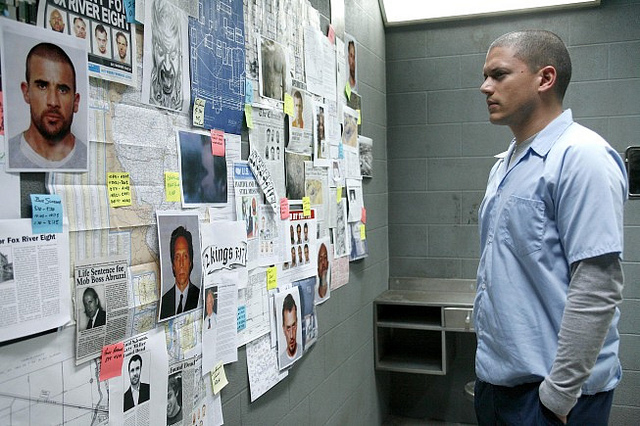
Moving on. You are probably already wondering how to work with it. Go to the methodology.
Methodology
There are two blocks: recommendations for drawing a map and the actual method.
Drawing guidelines
Probably the main thing - to try to use as many pictures as possible to illustrate the "branches" of the card. And it does not matter, beautiful pictures or not, the brain does not care. If a little more detailed, then:
1. Write-draw freely, do not think about the structure
2. Phrase phrases are short, single words are better
3. The more related images, the better.
4. Multicolour and volume
5. The more drawing space, the better.
About freedom, I mean that you don’t need to put yourself in the rigid framework of hierarchies and other things, it slows down the idea, you have to write down everything that comes to mind, it’s enough just to stick to the radial structure. Additionally, you can arrange the second iteration.
Individual words, and even better with pictures, are remembered, but the sentences are no longer there, for the brain it's just a set of characters, you have to compress everything to the point and clothe it in an image. Different colors also contribute to better fixation of the circuit in memory.
And of course, the sheet is desirable to have a large format (not less than A4). The card “grows” very quickly in all directions, and the borders of the sheet will constrain thoughts (if there is no large format at hand, I glue to the first A4 even on the sides and in the place where the card wants to “crawl out”, such clamshell turns out).
Method
Here, too, there is a division into analysis and synthesis. In general, the approaches are very similar, but there is a fundamental difference in analytics: it is necessary to translate someone else's linear information flow into a radial structure, while synthesizing, we create the structure ourselves.
Here are the stages that are characteristic of analytics:
1. Formulation of the subject of analytics
2. Creating a central image
3. Splitting a linear flow into a structure
4. Map — Hairbrush
5. Rebuilding the card for yourself
First you need to set a task. Why do we need a map that we analyze. This is a kind of filter for the brain that allows you to still remain in a given topic.
For example, we want to analyze a lecture or a book, for this we write the name / task in the center of the sheet (a lecture about the nature of sleep = “what is sleep?”) And draw an image (a sleeping person with a loot of thoughts above his head), which we associate with title or subject in general.
Further, as we listen to the lecture, we draw branches from the central image and fill them with the basic thoughts from the above.
If there is an analysis of an already completed information block, those of such material that can be “scrolled through”, then a radial filling of the map takes place (this technique underlies the speed reading) - first the topics from the table of contents, then the main subsections and the main ideas (which, as a rule, at the end of ). All of this we quickly flip through, not reading deeply, skipping those moments that are not immediately clear, you can return to them in the next round of filling the card (this is exactly the “combing”). Such circles are made until everything is clear. Is done.
When the primary map is ready and combed, it is set aside and on its basis a new one, already its own map, is drawn, which will be the result of analytics. If everything happens in the program, the old branches can be minimized or painted new over, highlighting them with color or symbols.
The following stages are characteristic of the synthesis:
1. Problem formulation
2. Coming up with a central image
3. Chaos-eruption of associations
4. Draft card # 1
5. Draft card # 2
6. ... etc. up to the option that suits (to the dash)
Also, as with analytics, a central image is first formed, which should include the formulation of the problem. For example: “Should I move to another city?”, “At what stage is the study of artificial intelligence?”, “Business plan of the billionth mobile photo-social network,” etc.
Chaos eruption map is not limited to anything but a clean flow. First, the first circle of branches is filled (their number is not limited too), then, each of them is filled with its own branches, etc. You can easily jump from branch to branch, put connections and dependencies. Even if there will be repetitions of branches, it's okay, on the contrary, it is a marker of importance. Such a chaos card is done in 10-15 minutes, not more.
The chaos card will perfectly outline the structure of the first draft, its main branches.
When working on the first draft, it should be borne in mind that the number of main branches must fit into a minimum focus (our consciousness can effectively keep 7 + -2 objects in focus).
Actually, here the stage from the analytics is repeated, namely: “rebuilding the map”. Those you look at the chaos card, select the most important from it and transfer it to the new draft card and proceed to filling it out, keeping the chaos card in view (it may not be useful, but it should be at hand will stupor).
Very often, the first draft already gives all the answers, but if it doesn’t happen, you can repeat everything - take a new sheet and make a new card, then you can look at the last draft and / or the chaos map.
Actually, when satisfaction / insight has come, you can translate all this into a linear form (for example, in such an article).
Additional chips for analytics and synthesis:
1. If there is a “gag” or not enough space, - you can make separate cards for these “gags”. For example, “cut off” one branch and turn it into a bush on a clean sheet and go back to the big card with the result.
2. Sometimes, especially during the synthesis, “bushes” can be very helpful with questions, even with completely general ones, such as: “why?”, “For whom?”, “When?”, Etc.
3. Incubation. It is useful to take breaks. Fully switch to another activity and then return. But the breaks should not be long, within a few hours.
In fact, your own style will eventually form, depending on the information you work with most often. You will have to assemble such a set of additional filters already inside the cards, which will help to disclose information and overcome “gags”.
On every day
Here I want to make a small digression and tell about one application of mind maps, which I use every day and which replaces all modern tools for planning and controlling tasks (yes, I haven't used Things for a long time and all sorts of daily planners and I’m completely happy with about this).
The basic idea is that you need to make several cards of different levels in one place and when planning your next actions, take into account the upper, strategic level of your life (of course, you need to create it beforehand by making the appropriate mind map “why am I living?”).
So, you will need 3 maps and a week pattern in the form in which you find it convenient for perception (this can be the format of a school diary or a weekly planner with a horizontal table for the whole week).
The first mind map is a list of what you want from life. In general.
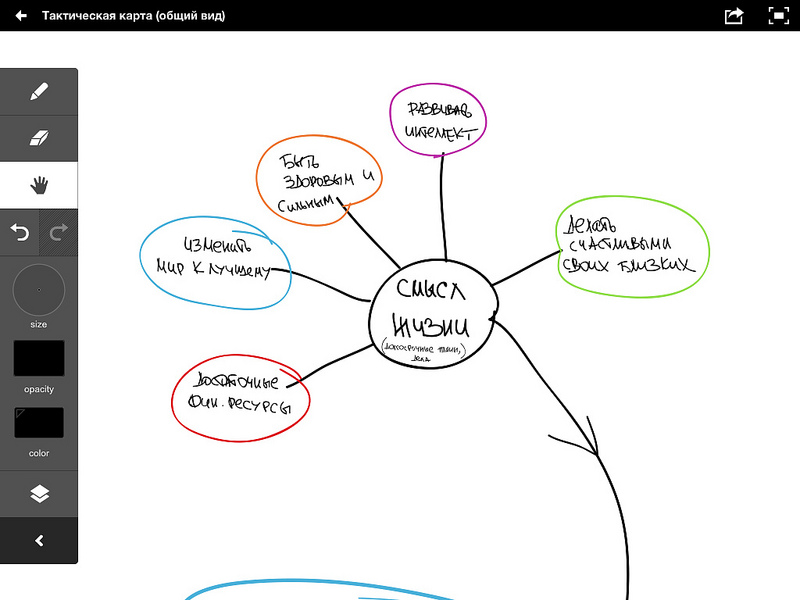
The second intellect map is the areas of your life (school, family, business, health, etc.) with an indication of current projects and perhaps some planned results on them.
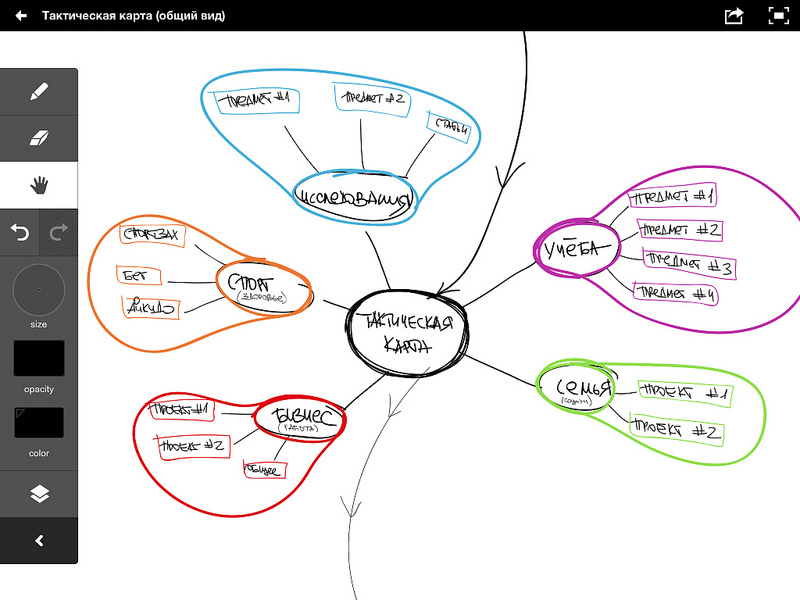
The third intelligence card is one day. The day and month are put in the center, you can also add some symbol of the day of the week (some image that you associate with a certain day, for example, for Friday there may be a beer mug). Branches - things that are planned for today. These cases are placed with an eye on the second card so that they are within the framework of current areas and projects.
Well, the pattern of the week is needed in order to put things in a certain sequence during the day, considering some repetitive events (lunch, gym, classes, etc.). This can be done in the form of a map, but I personally find it more convenient to sign a la iCal with the time indicated.

Schematically, it might look like this:

Instruments
There are a lot of tools for working with maps. I’ll tell you about the main ones I like the most.
A smartphone is always with you, sometimes it is very convenient to quickly put something in the queue or in the subway, where there are not so many places and you can’t arrange a drawing paper with a set of phlomics.
MindNode (iPhone) itunes.apple.com/ru/app/mindnode/id312220102?mt=8
MindJet (iPhone) itunes.apple.com/ru/app/mindjet-for-iphone/id440273648?mt=8
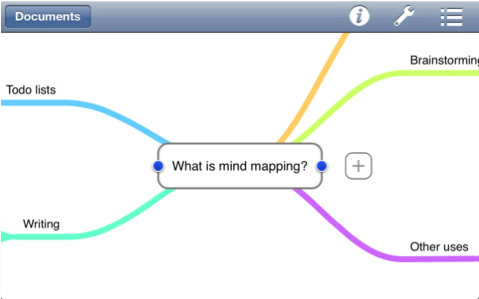

In desktop programs, cool enough functionality and the map can be customized.
MindNode (Win, Mac) www.mindnode.com
MindJet (Win, Mac) www.mindjet.com

Old school. Plain paper, only the format is desirable and more multi-colored pencils / pens (see illustration to the article). This is if there is a table. For the road, the unlineed Moleskine is very good and convenient, even with one handle.
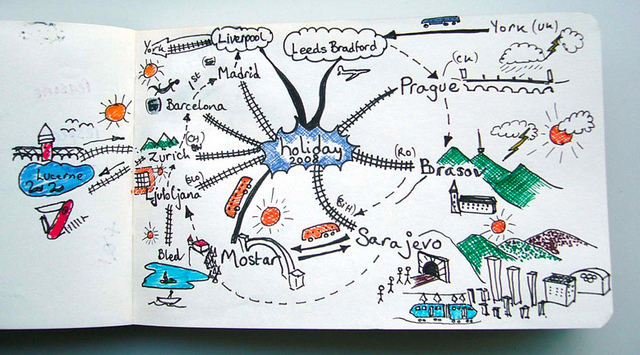
But the iPad combines a lot of what was listed above and it is usually always next to its owner. I will cite the example of 2 main programs: Mindo (or equivalent, MindNode) and Adobe Ideas. If you add a stylus to the last one, for example from Bamboo (the most convenient one I've tried), then you get something cosmic, in fact, you have a huge whiteboard with a set of colored markers of different diameters and washer. It is incredibly comfortable and cool!
Mindo itunes.apple.com/ru/app/mindo/id355182443?mt=8
Adobe Ideas itunes.apple.com/en/app/adobe-ideas/id364617858?mt=8

It turns out that I use all types of tools except desktop ones. Moreover, I choose according to the situation. In short, always ready!
Conclusion
On the one hand, this is a very simple tool and you’ll say nothing new, but on the other hand, if you add a format to this simplicity, then just due to its naturalness and as a result, speed, we get a powerful multi-variant enhancement tool the effectiveness of your thinking. We get in a few hours. And this is only the beginning, “+10” can turn into “+100” with time, you just need not stop, and use this tool to synthesize new, even cooler tools.
Links and what else to read / see
1. Mindmapper's Bible. Tony Buzan "Supermind" www.ozon.ru/context/detail/id/2678641
2. Probably the best guide to speed reading. Oleg Andreev. “Learning to read quickly” www.ozon.ru/context/detail/id/2455517
3. Vladimir Kozarenko. "Textbook mnemotehniki " mnemotexnika.narod.ru/uchebnik.htm
4. Konstantin Anokhin "Brain Codes" (Video) theoryandpractice.ru/videos/80-kody-mozga
5. Schedrovitsky G.P. "Selected Works" socioline.ru/pages/gp-schedrovitskij-izbrannye-trudy
Source: https://habr.com/ru/post/135075/
All Articles